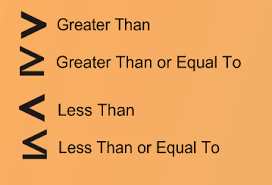Hello Aspirants,
In all of your exams, 5 questions come from the topic Inequalities in Reasoning Section. In these questions you are given some statements and conclusions, and based on the statements you are asked to tell the correctness of the conclusions.
First you should know the type of conclusions which are possible for the different inequalities statements.
The following table provides the conclusions which follows from different statements:
| S.No. | Statements | Conclusions which follows |
| 1 | A = B > C | A > C |
| 2 | A > B = C | |
| 3 | A > B ≥ C | |
| 4 | A ≥ B > C | |
| 5 | A > B > C | |
| 6 | A = B < C | A < C |
| 7 | A < B = C | |
| 8 | A < B ≤ C | |
| 9 | A ≤ B < C | |
| 10 | A < B < C | |
| 11 | A = B ≥ C | A ≥ C |
| 12 | A ≥ B = C | |
| 13 | A ≥ B ≥ C | |
| 14 | A = B ≤ C | A ≤ C |
| 15 | A ≤ B = C | |
| 16 | A ≤ B ≤ C | |
| 17 | A < B > C | No Relationship between A and C |
| 18 | A > B < C | |
| 19 | A < B ≥ C | |
| 20 | A ≤ B > C | |
| 21 | A > B ≤ C | |
| 22 | A ≥ B < C |
The following table provides the conclusions when the answer is either I or II conclusion is correct:
| S.No | Statements | Either I or II follows |
| 1 | A = B ≥ C | I. A > C II. A = C |
| 2 | A ≥ B = C | |
| 3 | A ≥ B ≥ C | |
| 4 | A = B ≤ C | I. A < C II. A = C |
| 5 | A ≤ B = C | |
| 6 | A ≤ B ≤ C | |
| 7 | A < B > C | a) I. A > C II. A ≤ C b) I. A < C II. A ≥ C |
| 8 | A > B < C | |
| 9 | A < B ≥ C | |
| 10 | A ≤ B > C | |
| 11 | A > B ≤ C | |
| 12 | A ≥ B < C |
Notice that the statements in table 2 are same as statements 11-22 of the first table. When these conclusions are given in pair the answer is either I or II and when only 1 of these conclusions is given then it does not follow.
The questions on inequalities are asked in 2 types:
TYPE I: Indirect inequalities
In this you are given inequalities in indirect way like
‘P # Q’ means ‘P is neither greater than nor equal to Q’.
‘P © Q’ means ‘P is neither equal to nor smaller than Q’.
‘P % Q’ means ‘P is neither smaller than nor greater than Q’
‘P $ Q’ means ‘P is not smaller than Q’.
‘P @ Q’ means ‘P is not greater than Q’.
When this type of information is given, first write on the paper what these symbols mean, like here
# means <
© means >
% means =
$ means ≥
@ means ≤
Example statement: L $ T, T % P, K © P
Now write the relation between elements in a single line by checking the above meanings of symbol as L ≥ T = P < K [Here K > P, but to write in a single line we will write as P < K]
Conclusions: I. P @ L II. L © K III. L @ K
I – L ≥ T = P means L ≥ P which is conclusion I P ≤ L, so I is true.
II – L ≥ T < K, so we know there is no relationship between L and K, so II if false.
III – L ≥ T < K, so we know there is no relationship between L and K, so III if false.
But II and III make either or pair, so answer is – I and either II or III follow.
TYPE 2: Direct Inequalities
In questions where direct inequalities are given in the statement itself, u need not form the relationship between elements like in above example. In these we will make relationship between elements in which conclusion is to be find.
Example Statement: A < P ≤ Q, L > Q < K, P ≥ O
Conclusions: I. K ≥ O II. L > O
K > Q ≥ P ≥ O, so K > O, so I is false
L > Q ≥ P ≥ O so L > O, so II is true



